中国文化概况_Chinese_religion
中国文化概况 复习资料

Chapter 1The Origin of Chinese Culture文化词汇Confucian philosophy 儒家哲学Confucius孔子Mencius孟子the descendants of Y an and Huang 炎黄子孙the Spring and Autumn and the Warring States Periods 春秋战国时期The Art of War《孙子兵法》porcelain 瓷器三皇五帝Three Emperors and Five Sovereigns)Gregorian calendar/ solar calendar格里高利历,是国际通用的历法,即公历lunar calendar阴历the Twenty-four Solar Terms二十四节气Chinese Zodiac生肖Chinese Culture---Past and PresentChinese history began with two legendary figures—Emperor Huang and Emperor Yan, who, together with their tribes, inhabited the drainage area along the middle reaches(中游)of the Yellow River. By the time of Xia Dynasty, after centuries of living side by side, these two tribes had gradually merged into(合并,融合)one. Consequently, the Chinese people usually call themselves “the descendants of Yan and Huang”.People at that time believed that the land they lived on was the center of the world, and called their state the "Middle Kingdom"(中国), thus giving China its country name.Traditional Chinese culture is recorded not only in history books and documents, but also in archeological records(考古记载), such as ancient city walls, palaces(宫殿), temples(寺庙), pagodas(宝塔), and grottos(洞窟); artifacts(史前古器物), such as bronze objects, weapons, bronze mirrors, coins, jade and pottery objects, and curios; and folk culture, including song and dance, embroidery(刺绣), cuisine(烹饪), clothing, tea ceremonies, drinking games, lanterns, riddles, martial arts(武术), chess and kites. With a continuous history of 5,000 years, it has undergone frequent transformations to produce a rich and vital cultural heritage.In the modern day, with the rise of western economic and military power beginning in the mid-19th century, Western systems of social and political organization have gained adherents in China. Indeed, within today’s globalized environment, modern cultures interact and cooperate increasingly more with each other. China’s culture of the future will most likely reflect this cross-cultural dimension. Thus, obtaining a solid understa nding of China’s culture of the past is necessary in order to successfully embrace all that the culture has to offer to the world.The Appellation of ChinaChina is the appellation of our country given by foreigners. The porcelain china is the transliteration of the place name Changnan(昌南), which was the old name for Jingdezhen(景德镇). The porcelain made in Changnan was smooth and bright, and earned another name of artificial jade. It became famous both home and abroad and was exported to Europe in large quantities.As time passed, people in Europe forgot the meaning of Changnan and switched the original meaning of porcelain of the word “china” to the place of its origin.The Alternative Names of China⏹Chixian, Shenzhou(赤县、神州)⏹Jiuzhou (九州)⏹Hua ( 华)⏹Huaxia(华夏)⏹Zhonghua(中华)⏹Hainei(海内)Chinese MythologyChinese Mythology is a collection of cultural history, folktales(民间故事), and religions that have been passed down in oral or written form. Chinese mythology is similar to modern religion in that they both believe in relationships between mankind and a higher power.Historians have conjectured(推测)that Chinese mythology began in 12th century BC (close to the time of the Trojan War 特洛伊战争). The myths and legends were passed down in oral form for over a thousand years, before being written down in early book such as Shui Jing Zhu and Shan Hai Jing.The classification of myth神话的分类Creation myth 创世神话:Nvwa Created Man(女娲造人)Hero myth 英雄神话:Houyi Shooting the Sun(后羿射日)War myth 战争神话:Yellow Emperor Tackled Human-God(黄帝擒蚩尤)Cultural MosaicHeavenly Stems and Earthly BranchesThe standard Gregorian calendar is generally referred to as the solar calendar in China. The traditional Chinese lunar calendar, also known as the Jiazi calendar, counts the years in sixty-year cycles by combining two series of numbers---the 10 Heavenly Stems and 12 Earthly Branches.The Twenty-four Solar TermsThe traditional Chinese lunar year is divided into twenty-four solar terms, according to the position of the sun on the ecliptic in relationship to the earth. The solar terms designate agricultural periods, and can predict changing seasonal conditions, temperature, and weather throughout the course of the year. They are extremely important to agricultural production.Changes in the four seasons are determined by eight solar terms:立春( the Beginning of Spring),春分( the Spring Equinox ),立夏(the Beginning of Summer ),夏至(the Summer Solstice),立秋(the Beginning of Autumn),秋分( the Autumnal Equinox),立冬( the Beginning of Winter),冬至(the Winter Solstice )Changes in temperature are indicated by five solar terms:小暑Slight Heat ,大暑Great Heat ,处暑the Limit of Heat ,小寒Slight Cold ,大寒Great ColdChanging weather conditions are indicated by seven solar terms:雨水Rain Water ,谷雨Grain Rain ,白露White Dew ,寒露Cold Dew,霜降Frost's Descent ,小雪Slight Snow ,大雪Great Snow .Recurring natural phenomena are indicated by four solar terms:惊蛰the Waking of Insects ,清明Pure Brightness ,小满Grain Full,芒种Grain in EarChinese ZodiacIn ancient times, our ancestors counted the years with 10 heavenly stems and 12 earthly branches. Although this was scientific, most people were illiterate and could not memorize or calculate easily. Thus the animals that influenced people's lives were chosen to symbolize the terrestrial branches: the rat, ox, tiger, rabbit, dragon, snake, horse, sheep, monkey , rooster, dog and pig.Chapter 2 Culinary Culture文化词汇culinary厨房的,烹饪的;烹调用的cuisine烹饪,烹调法;菜肴main food主食,主粮(staple food )Fire temperature火候food tonic 食补“Food is the first necessity of the people”(“民以食为天。
中国文化概要(中英对照)
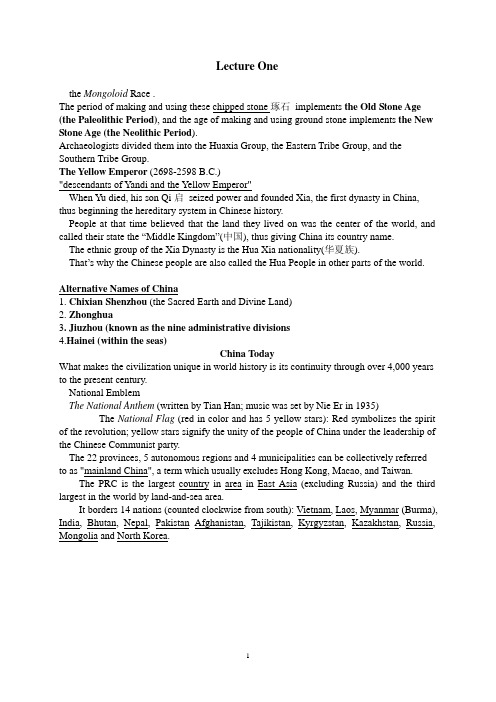
and linked by channels through which blood and qi(vital energy) circulate. If there is a blockage in either jing and luo, the blood and vital energy cannot pass through. To clear the blockage and ensure the free flow of blood and vital energy is the first and fundamental step in curing a disease.
Lecture One
the Mongoloid Race . The period of making and using these chipped stone 琢石 implements the Old Stone Age (the Paleolithic Period), and the age of making and using ground stone implements the New Stone Age (the Neolithic Period). Archaeologists divided them into the Huaxia Group, the Eastern Tribe Group, and the Southern Tribe Group. The Yellow Emperor (2698-2598 B.C.) "descendants of Yandi and the Yellow Emperor" When Yu died, his son Qi 启 seized power and founded Xia, the first dynasty in China, thus beginning the hereditary system in Chinese history. People at that time believed that the land they lived on was the center of the world, and called their state the “Middle Kingdom”(中国), thus giving China its country name. The ethnic group of the Xia Dynasty is the Hua Xia nationality(华夏族). That’s why the Chinese people are also called the Hua People in other parts of the world.
中国文化概况原文翻译

中国文化概况原文翻译《中国文化概况》是一部书籍,是从文化角度架起一座沟通中西的桥梁。
下面小编为大家整理了中国文化概况原文翻译,希望能帮到大家!一、The constitution of the people’s republic of china is the fundamental law of the state.中华人民共和国宪法是中国的根本法。
The NPC is the highest organ of state power. Local people’s congresses are local organs of state power. The standing committee of the NPC is the permanent organ of the NPC. The term of office of the NPC and its standing committee is 5 years. The NPC and its standing committee are empowered with the rights of legislation, decision, supervision, election and removal.全国人民代表大会是最高国家权力机关。
地方各级人民代表大会是地方权力机关。
全国人民代表大会常务委员会是全国人大的常设机关。
全国人大及其常委会任期是五年。
全国人大及其常委会有立法,决策,监督,选举和罢免的权力。
The communist party is the sole party in power in china. Apart from it, there are eight democratic parties in china. Multi-party cooperation and political consultation under the leadership of the CPC is the basic political system in china.共产党是中国唯一的执政党。
中国文化概况廖华英中英对照版
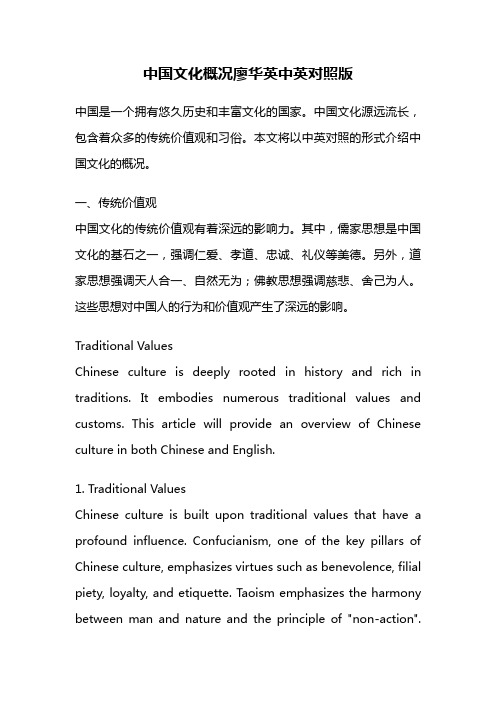
中国文化概况廖华英中英对照版中国是一个拥有悠久历史和丰富文化的国家。
中国文化源远流长,包含着众多的传统价值观和习俗。
本文将以中英对照的形式介绍中国文化的概况。
一、传统价值观中国文化的传统价值观有着深远的影响力。
其中,儒家思想是中国文化的基石之一,强调仁爱、孝道、忠诚、礼仪等美德。
另外,道家思想强调天人合一、自然无为;佛教思想强调慈悲、舍己为人。
这些思想对中国人的行为和价值观产生了深远的影响。
Traditional ValuesChinese culture is deeply rooted in history and rich in traditions. It embodies numerous traditional values and customs. This article will provide an overview of Chinese culture in both Chinese and English.1. Traditional ValuesChinese culture is built upon traditional values that have a profound influence. Confucianism, one of the key pillars of Chinese culture, emphasizes virtues such as benevolence, filial piety, loyalty, and etiquette. Taoism emphasizes the harmony between man and nature and the principle of "non-action".Buddhism emphasizes compassion and self-sacrifice. These philosophies have greatly shaped the behavior and values of the Chinese people.二、艺术与文学中国文化以其丰富多样的艺术形式而闻名。
中国文化概况哲学和宗教 英文版
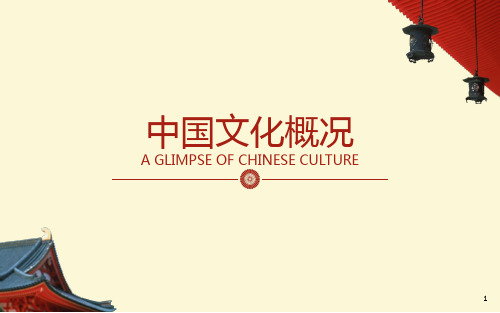
玄)”
theme: To explore the noumenon ( 本体) of the universe
mainly discusses the propositions of :
“existence versus non-existence”
“essentials versus non-essentials”
regards the words and deeds of Confucius as its highest code (准则) of behavior.
advocates: • the benevolence and justice, • allegiance and forbearance (仁、义、忠、恕), • the doctrine of the golden mean (中庸) • the ethical relations of men • family and social order
mainly discusses the relationship between human beings, between man and nature, and between man and society, as well as the nature of human beings
two main schools: the School of Principle (理学) the School of Mind (心学)
19
The Development of Chinese Philosophy
Neo-Confucianism During the Song and Ming Dynasties ( 宋明理学)
中国文化概况课件Unit 1-3chapter 2 Philosophy and religions
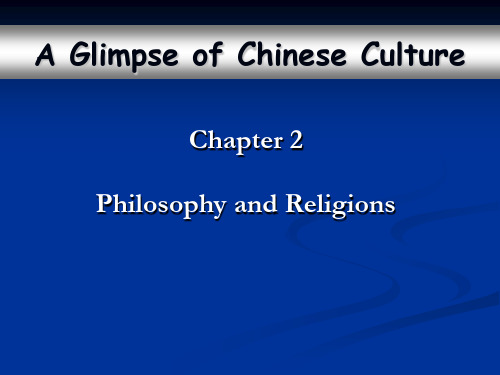
Confucianism
The school takes the teachings of Confucius as its core of thought and regards the words and deeds of Confucius as its highest code (准则) of behavior. It advocates the benevolence and justice, allegiance and forbearance (仁、义、忠、恕), the doctrine of the golden mean (中庸) and values the ethical relations of men.
The philosophy in Pre-Qin times (先秦子学)
The philosophy in Pre-Qin times was marked by the emergence of various ancient philosophical views. The most influential schools were Confucianism (儒家), Taoism (道家), Mohism (墨家) and Legalism (法家)
Legalism
Legalism, begun by Hanfeizi, espouses (主张) laying down laws to unify the thought of people, promoting agriculture to achieve affluence (富裕), waging (进行) wars to gain strength and power, and establishing a system of bureaucracy (官僚制度).
国学传统文化CHINESE TRADITIONAL CULTURE中国

添加标题
添加文本添加文本添
加文本添加
第二章节
添加标题 单击此处添加文本单击此处
添加文本单击此处添加
添加标题 单击此处添加文本单击此处
添加文本单击此处添加
第二章节
工作标题 02
单击此处添加文本单击此处添加文本 单击此处添加文本单击此处添加文本 单击此处添加文本单击此处添加文本单 击此处添加文本单击此处添加文本单击 此处添加文本单击此处添加文本
1
添加标题
0
此处添加文本单击此处添加
第三章节
单击此处添加标题
单击此处添加副标题或详细 文本描述单击此处添加副标
题或详细文本
单击此处添加标题
单击此处添加副标题或详细 文本描述单击此处添加副标
题或详细文本
单击此处添加标题
单击此处添加副标题或详细 文本描述单击此处添加副标
题或详细文本
第三章节
添加标题 单击此处添加文本单击此处添加文本单击此处添加 添加标题 单击此处添加文本单击此处添加文本单击此处添加 添加标题 单击此处添加文本单击此处添加文本单击此处添加
03
单击此处添加标题
点击添加相关标题文字,点击添加相关
04
单击此处添加标题
点击添加相关标题文字,点击添加相关
第四章节
76%
单击此处添加副标题或详 细文本描述单击此处添加 副标题或详细文本
38%
单击此处添加副标 题或详细文本描述 单击此处添加
53%
单击此处添加副标题或详 细文本描述单击此处添加 副标题或详细文本
第一章节
叁 单 单
击击 添添 加加 文文 本本
贰 单 单
击击 添添 加加 文文 本本
壹 单 单
中国文化概况哲学和宗教英文版

中国文化概况哲学和宗教英文版Chinese Culture Overview: Philosophy and ReligionPhilosophy:Confucianism is one of the most influential philosophies in Chinese history. Founded by Confucius during the Spring and Autumn Period (771 - 476 BCE), it focuses on moral values,social hierarchies, and the importance of education. Confucianism emphasizes the cultivation of virtues such as benevolence, righteousness, and filial piety. It has greatly influenced the development of Chinese governance, family ethics, and education systems.Taoism, founded by Lao Tzu during the 6th century BCE, explores the concept of the Tao, meaning "The Way." It emphasizes living in harmony with nature and the pursuit ofself-realization. Taoism encourages individuals to live a simple and balanced life, while seeking to attain immortality through spiritual practices such as meditation and martial arts. Its teachings have had a profound influence on Chinese literature, art, and traditional medicine.Legalism, originating during the Warring States Period (475 - 221 BCE), takes a more pragmatic approach to governance and social order. It emphasizes strict laws, harsh punishments, and the idea that human nature is inherently selfish and corrupt.Legalism played an important role in shaping the centralized autocracy of ancient China and laid down the foundation for the Qin Dynasty's legalistic governance.Mohism, founded by Mozi in the 5th century BCE, promotes universal love and altruism. Mohism advocates for impartiality and rejecting the discrimination based on social status. The philosophy emphasizes the practical application of moral principles for the benefit of society, calling for the equal distribution of resources and pacifism.Religion:Religion in China is diverse and multifaceted. The major religions practiced in China include Buddhism, Taoism, Confucianism, Islam, and Christianity.Taoism, as mentioned earlier, is both a philosophy and a religion. Taoist practices involve the worship of deities, participation in rituals, and the pursuit of immortality through meditation and alchemy. Taoist temples, many of which are located in natural landscapes, are important cultural and spiritual landmarks in China.Confucianism, although primarily a philosophy, incorporates certain religious elements. Ancestor worship is an integral part of Confucianism, as it emphasizes filial piety and respect for one's ancestors. Confucian temples and ancestral halls can befound throughout China, where rituals and ceremonies are conducted to honor and remember ancestors.Christianity arrived in China during the Tang Dynasty and has since grown steadily. Today, there are both official and unofficial Christian churches in China, with the officially recognized churches being regulated by the state. Chinese Christians practice their faith while incorporating Chinese cultural traditions, creating a distinct form of Chinese Christianity.In conclusion, Chinese philosophy and religion have significantly influenced the culture, values, and social structures of China. Confucianism, Taoism, Buddhism, and other unique philosophies have shaped Chinese attitudes towards morality, governance, and spirituality. Similarly, a variety of religions have found their place in Chinese society, enhancing the diversity and richness of Chinese culture.。
中国文化概况(英汉对照版)

四端午节 Dragon Boat Festival
五中秋节 MidAutumn Festival
六重阳节 Double Ninth Festival
课后练习题 Practice
一春节 Spring Festival
(一)起源与发展 Origin and Development (二)春节的传说 Legend of Spring Festival (三)习俗 Customs
四中国环保制 度 China’s Environmenta l Protection
Systems
课后练习题 Practice
一国旗、国徽、国歌 National Flag, National Emblem, National Anthem
(一)中华人民共和国国旗 The National Flag of the People’s Republic of China
六重阳节 Double Ninth Festival
(一)起源与发展 Origin and Development (二)重阳节的传说 Legend of Double Ninth Festival (三)习俗 Customs
一书法
1
Chinese
Calligraphy
二京剧
2
Peking
Opera
三 “一带一路”倡议 The Belt and Road Initiative
(一)共建原则 Principles (二)合作重点 Cooperation Priorities
一社会变迁中的家庭 生活 The Family Concept in Social Change
二中国人的现代生活 The Modern Life of Chinese People
中国文化概况哲学和宗教 英文版
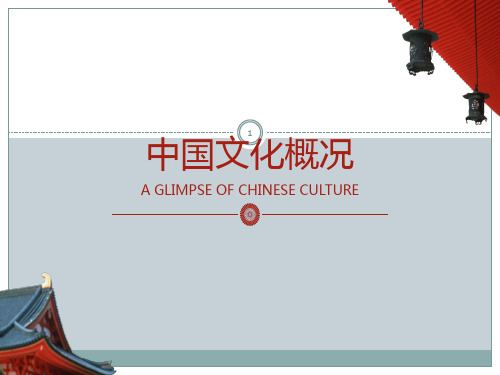
家), Mohism (墨家) and Legalism (法
家)
12
The Development of Chinese Philosophy
Philosophy During the Pre-Qin Times ( 先秦子学)
feudal rule. Orthodox philosophy advocates that Heaven affects
human affairs and human behaviour finds responses in
Heaven (天人感应). the power of the emperors are authorized by Heaven
base on the teaching of Mozi cherishes universal love honors virtuous people, opposes fatalism (宿命论) and
aggressive wars upholds thriftiness and simple funerals
reached its apex ( 顶点) during the Sui and Tang
dynasties mainly discusses the relationship between the
subjective and the objective attempts to gain insight into the universe and
Outline origins from the Xia, Shang, and Zhou dynasties began to take definite shape during the Spring and
中国文化概况英汉对照版
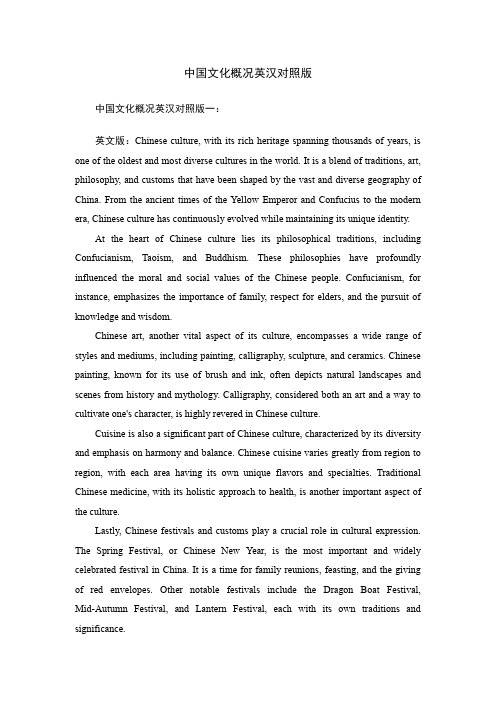
中国文化概况英汉对照版中国文化概况英汉对照版一:英文版:Chinese culture, with its rich heritage spanning thousands of years, is one of the oldest and most diverse cultures in the world. It is a blend of traditions, art, philosophy, and customs that have been shaped by the vast and diverse geography of China. From the ancient times of the Yellow Emperor and Confucius to the modern era, Chinese culture has continuously evolved while maintaining its unique identity.At the heart of Chinese culture lies its philosophical traditions, including Confucianism, Taoism, and Buddhism. These philosophies have profoundly influenced the moral and social values of the Chinese people. Confucianism, for instance, emphasizes the importance of family, respect for elders, and the pursuit of knowledge and wisdom.Chinese art, another vital aspect of its culture, encompasses a wide range of styles and mediums, including painting, calligraphy, sculpture, and ceramics. Chinese painting, known for its use of brush and ink, often depicts natural landscapes and scenes from history and mythology. Calligraphy, considered both an art and a way to cultivate one's character, is highly revered in Chinese culture.Cuisine is also a significant part of Chinese culture, characterized by its diversity and emphasis on harmony and balance. Chinese cuisine varies greatly from region to region, with each area having its own unique flavors and specialties. Traditional Chinese medicine, with its holistic approach to health, is another important aspect of the culture.Lastly, Chinese festivals and customs play a crucial role in cultural expression. The Spring Festival, or Chinese New Year, is the most important and widely celebrated festival in China. It is a time for family reunions, feasting, and the giving of red envelopes. Other notable festivals include the Dragon Boat Festival, Mid-Autumn Festival, and Lantern Festival, each with its own traditions and significance.汉语对照版:中国文化,拥有数千年的丰富遗产,是世界上最古老、最多样化的文化之一。
中国文化概况中英版

中国文化概况中英版An Overview of Chinese Culture (English Version)I. IntroductionChinese culture, with its long history and profound essence, is the sum of material and spiritual cultures created and passed down by the Chinese nation throughout its historical development. Chinese culture emphasizes humanism, focusing on moral values, etiquette, family, and social order.II. Main Contents1. History and EvolutionChinese culture boasts a rich history spanning thousands of years, from the Xia, Shang, and Zhou dynasties to the Spring and Autumn period, the Warring States period, and then to the Tang, Song, Yuan, Ming, and Qing dynasties. It has continuously absorbed and integrated foreign cultures, forming a unique cultural system.2. Traditional ValuesConfucianism is one of the cornerstones of Chinese culture, emphasizing virtues such as benevolence, filial piety, loyalty, and etiquette, which have profoundly influenced the behavior and values of the Chinese people. Taoism emphasizes the harmony between man and nature, advocating a natural and non-interventionist approach. Buddhism, on the other hand, emphasizes compassion and self-sacrifice, having a significant impact on Chinese religion and philosophy.3. Cultural Characteristics- Festival Culture: China has many traditional festivals, such as the Spring Festival, Mid-Autumn Festival, and Dragon Boat Festival, each with unique celebration methods and cultural connotations.- Clothing Culture: Traditional Chinese clothing, such as Hanfu and Tangzhuang, reflects the unique aesthetic concepts and cultural characteristics of the Chinese nation.- Architectural Culture: Traditional Chinese architecture, including palaces, temples, and gardens, is renowned for its distinctive styles and exquisite craftsmanship.- Cuisine Culture: Chinese cuisine, known for its rich flavors and exquisiteculinary techniques, is an important representation of China's cultural charm.4. Influence on the WorldThe values and ideological systems of Chinese culture have had a profound impact on the world, especially Confucianism, which has influenced Asia and beyond. Traditional Chinese arts and forms of expression, such as calligraphy, painting, and Peking Opera, are also deeply loved and admired by people around the world.III. ConclusionChinese culture is a treasure of the Chinese nation, embodying unique charm and value. Through learning and understanding Chinese culture, we can gain a deeper understanding of the history, traditions, and spiritual outlook of the Chinese people, further enhancing our sense of national pride and self-confidence. At the same time, Chinese culture has also made significant contributions to the diversity and development of world culture.中国文化概况中英版一、引言中国文化,源远流长,博大精深,是中华民族在长期历史发展过程中所创造并传承下来的物质文化和精神文化的总和。
中国文化概况作为课程名称的英文译文
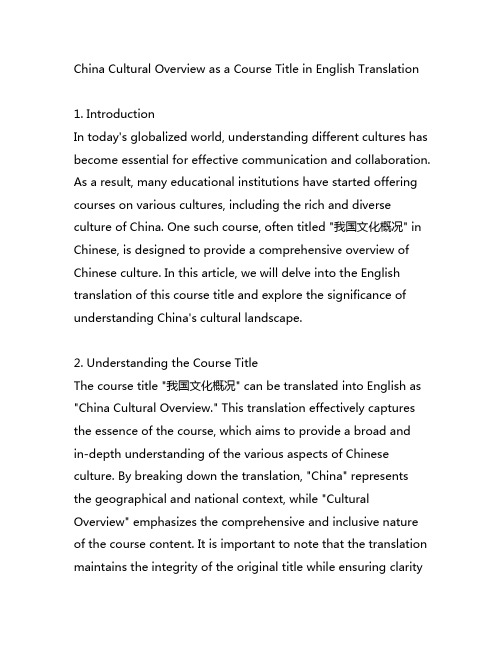
China Cultural Overview as a Course Title in English Translation1. IntroductionIn today's globalized world, understanding different cultures has become essential for effective communication and collaboration. As a result, many educational institutions have started offering courses on various cultures, including the rich and diverse culture of China. One such course, often titled "我国文化概况" in Chinese, is designed to provide a comprehensive overview of Chinese culture. In this article, we will delve into the English translation of this course title and explore the significance of understanding China's cultural landscape.2. Understanding the Course TitleThe course title "我国文化概况" can be translated into English as "China Cultural Overview." This translation effectively captures the essence of the course, which aims to provide a broad andin-depth understanding of the various aspects of Chinese culture. By breaking down the translation, "China" represents the geographical and national context, while "Cultural Overview" emphasizes the comprehensive and inclusive nature of the course content. It is important to note that the translation maintains the integrity of the original title while ensuring clarityand relevance in an English-speaking context.3. The Scope of the CourseA course titled "China Cultural Overview" encompasses a wide range of topics, including history, language, traditions, arts, literature, philosophy, religion, cuisine, and social customs. Through this course, students can gain insights into the historical and contemporary dimensions of Chinese culture, thereby developing a holistic perspective on the cultural identity of China. The interdisciplinary nature of the course allows for a multifaceted exploration of China's cultural heritage, enabling students to appreciate the complexities and nuances inherent in Chinese society.4. Personal ReflectionHaving studied and explored the intricacies of Chinese culture, I have come to appreciate the depth and richness of its traditions and practices. The course "China Cultural Overview" not only provided me with a comprehensive understanding of the historical and cultural foundations of China but also allowed me to critically examine the cultural stereotypes and misconceptions that often prevail in the global discourse. Through engaging with diverse sources and perspectives, I havedeveloped a profound respect for the diversity and resilience of Chinese culture, which continues to shape the country's identity on the world stage.5. Importance of Cultural UnderstandingThe English translation of "我国文化概况" as "China Cultural Overview" underscores the importance of cultural understanding and appreciation in today's interconnected world. By studying the cultural dynamics of China, students can cultivate intercultural competence and communication skills, which are essential for navigating cross-cultural interactions in diverse professional and social settings. Furthermore, gaining a deeper understanding of China's cultural landscape facilitates mutual respect and collaboration between individuals and institutions from different cultural backgrounds.6. ConclusionIn conclusion, the English translation of "我国文化概况" as "China Cultural Overview" encapsulates the essence and significance of the course in providing a comprehensive exploration of Chinese culture. Through an interdisciplinary approach, students are equipped with the knowledge and insights necessary to engage with China's cultural heritage in a meaningful and informedmanner. As our world continues to embrace cultural diversity, courses such as "China Cultural Overview" play a pivotal role in fostering mutual understanding and appreciation across borders and societies.In this article, we have delved into the English translation of the course title "我国文化概况" and discussed the relevance and significance of understanding the cultural landscape of China. I hope that this exploration has provided you with a deeper insight into the course and its implications for cultural understanding and engagement. As we continue to navigate the complexities of our globalized world, the study of diverse cultures, including that of China, remains an imperative for building bridges and fostering harmony across the cultural tapestry of humanity.。
中国文化概况总结英文作文
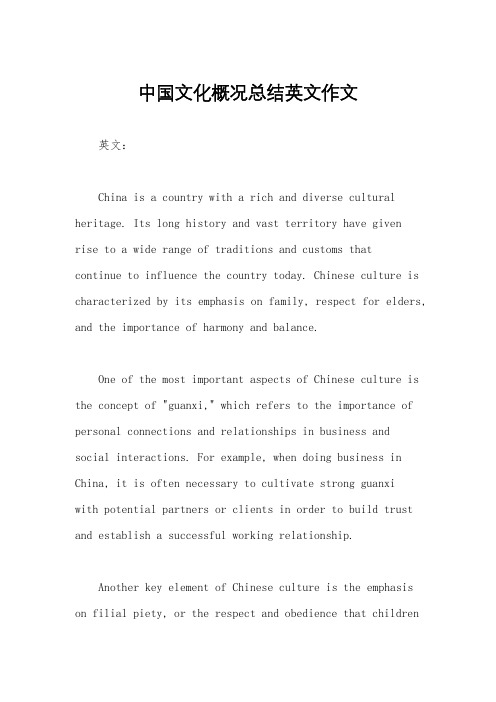
中国文化概况总结英文作文英文:China is a country with a rich and diverse cultural heritage. Its long history and vast territory have givenrise to a wide range of traditions and customs thatcontinue to influence the country today. Chinese culture is characterized by its emphasis on family, respect for elders, and the importance of harmony and balance.One of the most important aspects of Chinese culture is the concept of "guanxi," which refers to the importance of personal connections and relationships in business andsocial interactions. For example, when doing business in China, it is often necessary to cultivate strong guanxiwith potential partners or clients in order to build trust and establish a successful working relationship.Another key element of Chinese culture is the emphasis on filial piety, or the respect and obedience that childrenare expected to show towards their parents and elders. This can be seen in the way that Chinese families oftenprioritize the needs and wishes of their elders, and in the importance of ancestral worship and the veneration of ancestors.Chinese culture also places a strong emphasis on the concept of "face," which refers to a person's reputation, dignity, and social standing. For example, losing face in front of others is considered a major embarrassment, and it is important to avoid causing someone to lose face insocial interactions.In addition, Chinese culture is known for its rich artistic traditions, including calligraphy, painting, music, and dance. These art forms have been an important part of Chinese culture for thousands of years and continue to be celebrated and practiced today.Overall, Chinese culture is a complex and multifaceted phenomenon that encompasses a wide range of traditions, beliefs, and practices. Its influence can be seen ineverything from the way that people interact with each other to the way that they celebrate holidays and express themselves through art and literature.中文:中国是一个拥有丰富多样文化传统的国家。
中国及中国文化概况中英双语_OK

➢ 闯关东是以山东和直隶人为主,目的地是东三省一带;走西口是以山 西、陕西人为主,目的地是蒙古草原;下南洋是以广东和福建人为主, 目的地是东南亚一带。
➢ C is maily Shandong people and Zhili People, they moved to Northeast part of China; Immigration to the west is maily Shanxi, Shaanxi people, moved to I nner Mongolia grassland; Immigration to the south China sea maily Guangdon g and Fujian people, they moved to southeast asia areas.
12
National emblem
2021/10/7
13
National treasure Giant panda
2021/10/7
14
National flower
Mudan
2021/10/7
15
National bird
Red-crowned Cr ane
1500
East Asia, China, Japan, Russia, N orth Korea and South Korea
第三次大移民:发生在12世纪中期,大批移民走到了广东、广西、福建, 甚至海南岛等更靠南的地方。
Third immigration: In the mid 12th century, a large immigration moved to Guan gdong, Fujian, even Hainan island in the very south.
中国文化概况(英语)在线开放课程设计

中国文化概况(英语)在线开放课程设计【摘要】The course objectives include familiarizing students with key cultural elements, fostering cross-cultural connections, and enhancing cultural appreciation and communication skills.【关键词】中国文化、在线开放课程、设计、引言、概况、目标、课程结构、课程材料、评估方法、结论1. 引言1.1 IntroductionWelcome to the online course on Chinese culture! In this course, you will have the opportunity to explore the rich and diverse cultural heritage of China.Chinese culture is one of the oldest and most complex cultures in the world, with a history that dates back thousands of years. It encompasses a wide range of traditions, beliefs, arts, and practices that have been passed down through generations. From ancient philosophies such as Confucianism and Taoism, to traditional arts such as calligraphy and opera, Chinese culture is a treasure trove of wisdom and creativity.2. 正文2.1 Overview of Chinese CultureChina is a country with a rich and diverse cultural heritage that dates back thousands of years. Chinese culture is known for its ancient traditions, arts, language, philosophy, and cuisine. It is a culture that values harmony, family, and respect for ancestors.2.2 Course Objectives1. Understand the key historical events, philosophies, and traditions that have shaped Chinese culture throughout the centuries.2.3 Course StructureModule 2: Chinese Philosophy and Religion- In this module, students will learn about the major philosophical traditions in China, such as Confucianism, Daoism, and Buddhism.- The module will also cover the role of religion in Chinese society, including rituals, beliefs, and practices.2.4 Course MaterialsIn this online course on Chinese culture, a variety of materials will be utilized to enhance the learning experience of participants. These materials have been carefully selected to provide a comprehensive overview of Chinese culture, covering various aspects such as history, philosophy, literature, art, and traditions.2.5 Assessment MethodsIn this course on Chinese culture, students will be assessed using a variety of methods to ensure a comprehensive evaluation of their understanding and grasp of the content. The following assessment methods will be utilized:3. 结论3.1 ConclusionThe course objectives have been met through a combination of lectures, readings, discussions, and assignments that challenge students to think critically and creatively about the material. By the end of the course, students should have a solid foundation in Chinese culture and be able to engage with it in a meaningful way.。
- 1、下载文档前请自行甄别文档内容的完整性,平台不提供额外的编辑、内容补充、找答案等附加服务。
- 2、"仅部分预览"的文档,不可在线预览部分如存在完整性等问题,可反馈申请退款(可完整预览的文档不适用该条件!)。
- 3、如文档侵犯您的权益,请联系客服反馈,我们会尽快为您处理(人工客服工作时间:9:00-18:30)。
It was named after the white horse that carried the Buddhist scriptures from India to Luoyang, then the capital of the country.
The Famous Buddhism Mountains
Mosque (清真寺)
• A mosque is always a high-domed building with sweeping arches, flowing arabesques (蔓藤花纹) and towering minarets (高耸的尖塔). • Inside, a mihrab, or niche (壁龛), which symbolizes the place where the prophet (先知) led the prayer, is set into the middle of the qibla wall in order to indicate the direction of Mecca (麦加).
• In front of Taoist temples, there are mountain gates, Huabiao (marble pillar) and fan’gan (幡杆). • Outside the Huabiao is the earthly world (俗界), inside it is the celestial place (仙界).
The most sacred Taoist mountain —Dragon-Tiger Mountain
• Dragon-Tiger Mountain is located at the southwestern suburb of Yingtan, Jiangxi Province. It is the birthplace of the Taoist religion.
The doctrine of Four Noble Truths (四谛)
• • • • life is suffering, the cause of suffering is desire, the answer is to quench (抑制) desire, the way to this end is to follow the Eight-Fold Path (八正道).
Buddhism Temples
• Chinese Buddhist architecture includes pagodas, temples and grottos. Earlier Buddhist temples usually combined pagodas and a courtyard-style temple.
Other religions
• Christianity(基督教)
• Catholicism(天主教)
THANK YOU!!!
The Taoist Religion(道教)
• Taoism is the indigenous (土生土长的) religion in China. • Lu Xun once said, “The Chinese roots are deep in Taoism. If one tries to comprehend Chinese history and culture, he must first comprehend Taoism and the Taoist religion.” • The Taoist religion evolved out of witchcraft (巫术), necromancy(方术 ) and selfcultivation techniques. Its highest belief is called “Dao”, its bible is called “Dao De Jing”.
The First Buddhist Temple —The White Horse Temple
• The White Horse Temple, located 21 km east of the Luoyang City, Henan Province, was the first officially built Buddhist temple in China in the Eastern Han Dynasty.
According to a legend, when the elixirs were made, a dragon and a tiger were seen above the mountain. So, the mountain was renamed after the celestial animals (“丹成而龙虎 现,山因以名”).
安徽齐云山
江西龙虎山
ቤተ መጻሕፍቲ ባይዱ
湖北武当山
四川青城山
Buddhism(佛教)
• Buddhism originated in India in the 6th century B.C. Sakyamuni is said to be the founder of Buddhism. • Buddhism was first introduced into China in the first century. During the Sui and Tang dynasties, Buddhism entered its golden age. • The theory of Buddhism is based on the theory of samsara (轮回),meaning that living beings orbit around the six spheres of heaven, hell and earth, just like an everturning wheel.
Islam(伊斯兰教)
• Islam was founded by the Arabic prophet (先知) Mohammed and was introduced into China in the seventh century. For people of Islamic faith, there is only one God, Allah. • The Arabic word “Islam” simply means “submission and obedience”.
Chinese Religions
金融1班
汪晓磊
工程
尹宏全
Chinese Religions
• China is multi-religion country.
• There are indigenous Taoist religion, all forms of folk religions, and religion of foreign origins such as Buddhism, Islam, and Christianity.
Zhang Daoling
• The Taoist religion was founded by Zhang Daoling in the Eastern Han Dynasty and became very popular during the Southern and Northern Dynasties.
Eight Immortals in the Taoist religion
• The story about the Eight Immortals have been so popular and influential in Chinese society. • There is a famous saying about them :“Wh en the Eight Immortals cross the sea,each demonstrates his/her diving power”.They r epresent eight factors in Chinese people’s daily life.
Taishang laojun
• Taoists revered (尊崇) Lao Zi as the originator of the Taoist religion and called him “Taishang Laojun” (太 上老君).
Taoism Temples
• Taoism temples are places for Taoist priests to self-reflect and carry out their religious activities. The layout of the Taoism temples evolved from the traditional square-shaped Chinese courtyard, also resembling that of Buddhist temples in design.
